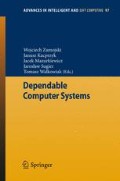Abstract
Right from the beginning, the fault tree language gained great acceptance in reliability modeling, because it bears a striking resemblance to the operators found in the classical logic. Therefore, only by using ‘AND’ as well as ‘OR’ gates a number of system failures can be expressed even by engineers not related to reliability analysis. Doubtless, intuition accompanying fault tree models is their greatest merit. Therefore each attempt to increase their expressive power by introducing a set of very specific model extensions strives to retain the intuitiveness. The most remarkable extensions are dynamic gates and repair boxes. However, these extensions are strictly limited to expressing time dependencies like a sequence of time consuming activities or time redundancy. From this viewpoint, fault trees and Petri nets complement one another. The latter offer huge modeling power comparative to Turing machines, but their models turned out to be obscure to engineers. Hence, this severe limitation hampers widespread popularity of Petri Nets. By analyzing the constraints of the two languages, we come up with a new modeling technique blending fault trees with Petri nets. We extend the expressive power of fault trees by adding Petri net immediate transitions. The obtained fault graphs with time dependencies are investigated by modeling several repair policies on some exemplary computer system. Availability calculations of the system are possible owing to a dedicated tool.
Access this chapter
Tax calculation will be finalised at checkout
Purchases are for personal use only
Preview
Unable to display preview. Download preview PDF.
References
Ajmone Marsan, M., Balbo, G., Conte, G.: A class of generalized stochastic Petri nets for the performance evaluation of multiprocessor systems. ACM Transactions on Computer Systems 2, 93–122 (1984)
Babczyński, T., Łukowicz, M., Magott, J.: Time coordination of distance protections using probabilistic fault trees with time dependencies. IEEE Transaction on Power Delivery 25(3), 1402–1409 (2010)
Bobbio, A., Codetta, D.: Parametric fault trees with dynamic gates and repair boxes. In: Proc. Annual Symposium on Reliability and Maintainability, pp. 459–465 (2004)
Codetta, D., Franceschinis, G., Iacono, M., Vittorini, V.: Repairable fault tree for the automatic evaluation of repair policies. In: Proc. Proceedings of the International Conference on Dependable Systems and Networks, DSN 2004 (2004)
Dugan, J.B., Bavuso, S.J., Boyd, M.A.: Dynamic fault-tree models for fault-tolerant computer systems. IEEE Trans. Reliab. 41(3), 363–367 (1992)
International Technical Commission, Fault Tree Analysis (FTA), Publication 1025 (1990)
Górski, J.: Extending Safety Analysis Techniques with Formal Semantics, Technology and Assessment of Safety-Critical Systems, pp. 147–163. T. Springer-Verlag, Heidelberg (1994)
Górski, J., Magott, J., Wardzinski, A.: Modelling fault trees using Petri nets. In: Proc. SAFECOMP 1995, Belgirate, Italy. LNCS, Springer, Heidelberg (1995)
ISO/IEC 15909-1, High-level Petri nets: Concepts, definitions and graphical notation (2004)
Kowalski, M., Magott, J.: Fault graphs with time dependencies (in Polish). Problemy eksploatacji, Maintenance Problems (1), 117–128 (2011)
Magott, J., Skrobanek, P.: A Method of Analysis of Fault Trees with Time Dependencies. In: Koornneef, F., van der Meulen, M.J.P. (eds.) SAFECOMP 2000. LNCS, vol. 1943, pp. 176–186. Springer, Heidelberg (2000)
Magott, J., Skrobanek, P.: Method of time Petri net analysis for analysis of fault trees with time dependencies. In: IEE Proceedings - Computers and Digital Techniques, vol. 149(6), pp. 257–271 (2002)
Montani, S., Portinale, L., Bobbio, A., Codetta-Raiteri, D.: RADYBAN: a tool for reliability analysis of dynamic fault trees through conversion into dynamic Bayesian networks. In: Reliability Engineering and System Safety, vol. 93(7), pp. 922–932 (2008)
RELEX, Resources on Fault Trees (2010), http://www.relex.com/resources/art
Author information
Authors and Affiliations
Editor information
Editors and Affiliations
Rights and permissions
Copyright information
© 2011 Springer-Verlag Berlin Heidelberg
About this paper
Cite this paper
Kowalski, M., Magott, J. (2011). Conjoining Fault Trees with Petri Nets to Model Repair Policies. In: Zamojski, W., Kacprzyk, J., Mazurkiewicz, J., Sugier, J., Walkowiak, T. (eds) Dependable Computer Systems. Advances in Intelligent and Soft Computing, vol 97. Springer, Berlin, Heidelberg. https://doi.org/10.1007/978-3-642-21393-9_10
Download citation
DOI: https://doi.org/10.1007/978-3-642-21393-9_10
Publisher Name: Springer, Berlin, Heidelberg
Print ISBN: 978-3-642-21392-2
Online ISBN: 978-3-642-21393-9
eBook Packages: EngineeringEngineering (R0)

